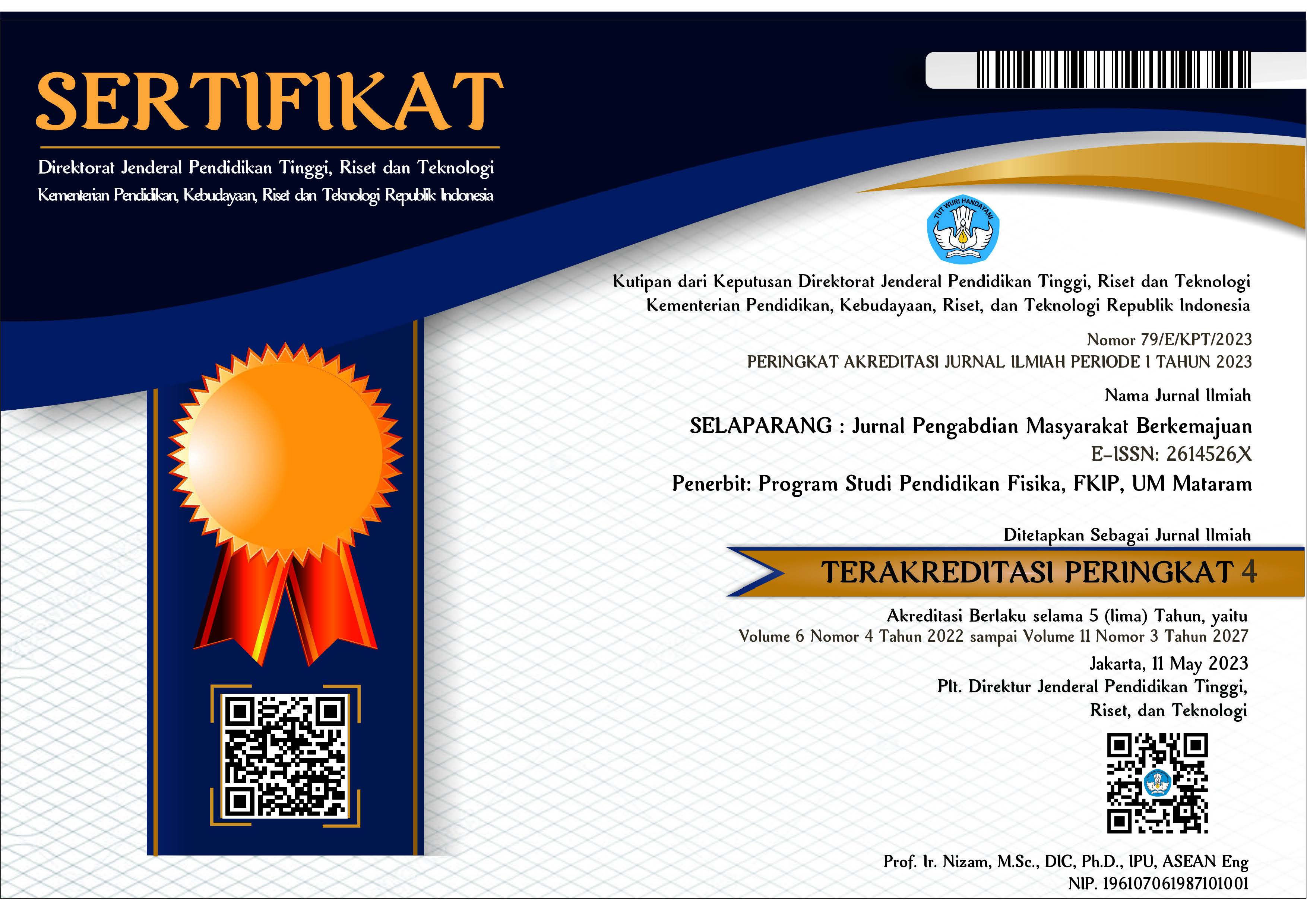PANGAN FUNGSIONAL UNTUK PROYEK INDEPENDEN KKN-TEMATIK DI MASA PANDEMI COVID-19
Abstract
ABSTRAK
Pandemi covid-19 telah membuat manusia banyak menderita penyakit hingga meninggal dunia di berbagai belahan dunia. Konsumsi pangan fungsional dapat memberikan manfaat kesehatan fisiologis dalam melawan dan terlindungi dari covid-19. Tujuan dari kegiatan pengabdian kepada masyarakat ini adalah mengenalkan pangan fungsional untuk proyek independen KKN-Tematik dalam program Merdeka Belajar Kampus Merdeka (MBKM). Melalui kegiatan proyek independen, mahasiswa dapat merancang pangan fungsional berbasis potensi desa sebagai produk akhir inovatifnya. Kegiatan pengabdian kepada masyarakat berlangsung pada tanggal 9 dan 16 September 2021 secara luring dan daring dengan menggunakan metode knowledge rasfer dan Community development. Kegiatan ini terdiri dari tahapan persiapan, pelaksanaan, dan evaluasi. Evaluasi kegiatan dilakukan menggunakan rubrik penilaian tugas dan angket persepsi mahasiswa. Hasil kegiatan pengabdian kepada masyarakat menunjukkan bahwa 1) mahasiswa telah mampu memetakan potensi sumber daya alam desa; 2) mahasiswa sudah memahami konsep senyawa bioaktif; dan 3) mahasiswa dapat menggunakan referensi ilmiah sebagai dasar proyek. Tanggapan mahasiswa terhadap kegiatan pengabdian kepada masyarakat sangat positif.
Kata kunci: pangan fungsional; proyek independen; KKN; pandemi covid 19
ABSTRACT
The COVID-19 pandemic has caused many people to suffer from diseases and die in various parts of the world. Consumption of functional foods can provide physiological health benefits in fighting and protecting against COVID-19. The purpose of this community service activity is to introduce functional food for the Thematic-KKN independent project in the Merdeka Learning Campus Merdeka (MBKM) program. Through independent project activities, students can design functional food based on village potential as an innovative final product. Community service activities take place on 9 and 16 September 2021 offline and online using the knowledge transfer and community development methods. This activity consists of the preparation, implementation, and evaluation stages. Evaluation of activities was carried out using the assignment assessment rubric and student perception questionnaires. The results of community service activities show that 1) students have been able to map the potential of village natural resources; 2) students already understand the concept of bioactive compounds; and 3) students can use scientific references as the basis for the project. Student responses to community service activities were very positive.
Keywords: functional food; independent project; community service program; covid 19 pandemic
Keywords
Full Text:
PDFReferences
Andarwulan, N., Kurniasih, D., Apriady, R. A., Rahmat, H., Roto, A. V., & Bolling, B. W. (2012). Polyphenols, carotenoids, and ascorbic acid in underutilized medicinal vegetables. Journal of Functional Foods, 4(1), 339–347. https://doi.org/10.1016/j.jff.2012.01.003
Canrinus, E. T., Bergem, O. K., Klette, K., & Hammerness, K. (2017). Coherent teacher education programmes: Taking a student perspective. Journal of Curriculum Studies, 49(3), 313–333. https://doi.org/10.1080/00220272.2015.1124145
Feinstein, J. (2008). The Importance of Accurate References in Journals. Editors’ Bulletin, 4(3), 100–102. https://doi.org/10.1080/17521740802651237
Foster, C., Francome, T., Hewitt, D., & Shore, C. (2021). Principles for the design of a fully-resourced, coherent, research-informed school mathematics curriculum. Journal of Curriculum Studies, 53(5), 621–641. https://doi.org/10.1080/00220272.2021.1902569
Harianti, R., Marliyati, S. A., Rimbawan, R., & Sukandar, D. (2018). Development of High Antioxidant Red Palm Oil Cake as a Potential Functional Food. Jurnal Gizi Dan Pangan, 13(2), 63–70. https://doi.org/10.25182/jgp.2018.13.2.63-70
Hasler, C. M. (2002). Functional Foods: Benefits, Concerns and Challenges—A Position Paper from the American Council on Science and Health. The Journal of Nutrition, 132(12), 3772–3781. https://doi.org/10.1093/jn/132.12.3772
Jiang, L.-L., Gong, X., Ji, M.-Y., Wang, C.-C., Wang, J.-H., & Li, M.-H. (2020). Bioactive Compounds from Plant-Based Functional Foods: A Promising Choice for the Prevention and Management of Hyperuricemia. Foods, 9(8), 973. https://doi.org/10.3390/foods9080973
Kemenkes RI. (2020). Keputusan Menteri Kesehatan Republik Indonesia Nomor HK.01.07/MENKES/328/2020—Protokol. Covid19.Go.Id. https://covid19.go.id/p/protokol/panduan-pencegahan-dan-pengendalian-corona-virus-disease-2019-covid-19-di-tempat-kerja-perkantoran-dan-industri-dalam-mendukung-keberlangsungan-usaha-pada-situasi-pandemi
Kementrian Pendidikan dan Kebudayaan. (2020). Buku Panduan Merdeka Belajar: Kampus Merdeka – Direktorat Jenderal Pendidikan Tinggi Kementerian Pendidikan dan Kebudayaan Republik Indonesia. https://dikti.kemdikbud.go.id/pengumuman/buku-panduan-merdeka-belajar-kampus-merdeka/
Khery, Y., Dewi, A. D., & Bilad, M. R. (2021). Pedoman kurikulum MBKM program studi pendidikan kimia. Program Studi Pendidikan Kimia Universitas Pendidikan Mandalika.
Knorr, D., & Watzke, H. (2019). Food Processing at a Crossroad. Frontiers in Nutrition, 6, 85. https://doi.org/10.3389/fnut.2019.00085
Kurnia, N., Liliasari, Supriyanti, F. M. T., & Adawiyah, D. R. (2020). Functional food project: A new and enjoyable topic in a food chemistry course. Journal of Physics: Conference Series, 1440, 012010. https://doi.org/10.1088/1742-6596/1440/1/012010
Kusmiyati, K., Rasmi, D. A. C., Khairuddin, K., Sedijani, P., & Handayani, B. S. (2021). Penyuluhan Tentang Usaha Perbaikan Gizi Keluarga (UPGK) Melalui Pemanfaatan Pekarangan dimasa Pandemi Covid 19. Jurnal Pengabdian Magister Pendidikan IPA, 4(3). https://doi.org/10.29303/jpmpi.v4i3.967
Macagnan, F. T., da Silva, L. P., & Hecktheuer, L. H. (2016). Dietary fibre: The scientific search for an ideal definition and methodology of analysis, and its physiological importance as a carrier of bioactive compounds. Food Research International, 85, 144–154. https://doi.org/10.1016/j.foodres.2016.04.032
Maleki, S. J., Crespo, J. F., & Cabanillas, B. (2019). Anti-inflammatory effects of flavonoids. Food Chemistry, 299, 125124. https://doi.org/10.1016/j.foodchem.2019.125124
Miller, M. D., Linn, R. L., Gronlund, N. E., & Linn, R. L. (2009). Measurement and assessment in teaching (10th ed). Merrill/Pearson.
Nicoletti, M. (2012). Nutraceuticals and botanicals: Overview and perspectives. International Journal of Food Sciences and Nutrition, 63(sup1), 2–6. https://doi.org/10.3109/09637486.2011.628012
Noviasari, S., Kusnandar, F., Setiyono, A., & Budijanto, S. (2015). BERAS ANALOG SEBAGAI PANGAN FUNGSIONAL DENGAN INDEKS GLIKEMIK RENDAH. Jurnal Gizi Dan Pangan, 10(3), Article 3. https://doi.org/10.25182/jgp.2015.10.3.%p
Pamungkas, A., Sulaeman, A., & Roosita, K. (2014). PENGEMBANGAN PRODUK MINUMAN JELI EKSTRAK DAUN HANTAP (Sterculia oblongata R. Brown) SEBAGAI ALTERNATIF PANGAN FUNGSIONAL. Jurnal Gizi Dan Pangan, 9(3), Article 3. https://doi.org/10.25182/jgp.2014.9.3.%p
Panche, A. N., Diwan, A. D., & Chandra, S. R. (2016). Flavonoids: An overview. Journal of Nutritional Science, 5. https://doi.org/10.1017/jns.2016.41
Santini, A. (2018). The Importance of Referencing. The Journal of Critical Care Medicine, 4(1), 3–4. https://doi.org/10.2478/jccm-2018-0002
Satgas Covid 19. (n.d.). Analisis Data COVID-19 Indonesia (Update Per 29 Agustus 2021)—Berita Terkini | Covid19.go.id. Retrieved 7 November 2021, from https://covid19.go.id/p/berita/analisis-data-covid-19-indonesia-update-29-agustus-2021
Teodoro, A. J. (2019). Bioactive Compounds of Food: Their Role in the Prevention and Treatment of Diseases. Oxidative Medicine and Cellular Longevity, 2019, e3765986. https://doi.org/10.1155/2019/3765986
DOI: https://doi.org/10.31764/jpmb.v5i1.5749
Refbacks
- There are currently no refbacks.

This work is licensed under a Creative Commons Attribution-ShareAlike 4.0 International License.
______________________________________________________
Jurnal Selaparang
p-ISSN 2614-5251 || e-ISSN 2614-526X
EDITORIAL OFFICE:



















